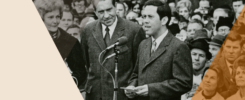Written and Performed by Justin Clark. Produced by Jill Weiss Simins
During the peak of labor struggles in the early 20th century, almost no figure was as recognized and loved by workers than Mary “Mother” Jones. An Irish immigrant who dedicated her life to cause of labor, Jones was described by the Evansville Courier as “probably the most widely known woman labor leader in the United States.” That was certainly the case here in Indiana. During her decades in the labor struggle, Mother Jones traveled all around the country organizing coal miners, catching the ire of mine owners and the political leaders that supported them. However, one member of the political establishment that Jones not only liked but publicly supported was Democratic U. S. Senator from Indiana John W. Kern. A dedicated defender of organized labor himself, Kern used his power as the U.S. Senate Majority Leader to advocate for Jones’s release in the summer of 1913 when she was wrongfully imprisoned during a labor strike. Years later, she campaigned on his behalf, reminding the labor movement that Kern stood up for her when very few public leaders would. Their political partnership stands out as one of the most unique pairings during America’s Progressive Age.
I’m Justin Clark and this is a short episode of Talking Hoosier History.
Life as a worker in the coal mines was treacherous. In Evansville, Indiana, for example, miners were regularly injured or even killed, with local newspapers chronicling mining disasters for decades. Frank Hudson, a 19-year-old miner who worked at the Diamond Coal Company’s mines in Evansville, was “crushed to death” by “a heavy piece of soapstone” near a worksite entrance in 1888. In 1897, a miner named William Delgeman was nearly killed at the Diamond coal mine by a premature blast explosion, leaving him with a broken arm and severe burns. In 1902, William Cox, died of injuries sustained when slate fell on him.
Due to the horrific circumstances in Indiana and elsewhere in the late 19th and early 20th century, workers began to organize. The powerful United Mine Workers of America (UMWA) was founded in 1890 and based its operations of out Indiana. Mother Jones worked for the UMWA for over 30 years, organizing workers nationwide.
In addition to organizing in Indiana, Mother Jones spent a lot of time in West Virginia, where she was imprisoned during a strike in 1912. Jones, along with 48 other labor organizers, were charged with “conspiracy to murder” for the death of Fred Bobbett, who died during a labor uprising. She was left in appalling conditions for months, cramped in a small cell with very little sunlight or adequate food. She appealed to public officials about her imprisonment and the conditions the miners faced.
In an unlikely twist, her most staunch defender was a man at the top of national politics, democratic Senator John Kern. Upon learning of the conditions that she and the others imprisoned experienced, Senator Kern opened an inquiry into the mines of West Virginia and read a telegram from Mother Jones on the Senate floor. Jones recounted this telegram in her autobiography:
From out the military prison walls of Pratt, West Virginia, where I have walked over my eighty-fourth milestone in history, I send you the groans and tears and heartaches of men, women and children as I have heard them in this state. From out these prison walls, I plead with you for the honor of the nation, to push that investigation, and the children yet unborn will rise and call you blessed.
He received swift backlash for his actions by his West Virginian colleagues in the Senate, who tried to block Kern’s resolution calling for investigations into the mines and their owners. The men from West Virginia were no match for the Senate Majority Leader, however, and on May 27, 1913, the Senate adopted Kern’s resolution and a “broad [congressional] investigation” on the conditions of the coal mines in West Virginia. Partially because of Kern’s efforts, Mother Jones was also released from jail.
In telling any story about Mother Jones, it’s important to keep one thing in mind: her Autobiography, while valuable in many respects, often gets basic facts wrong. For example, in discussing Senator Kern in her Autobiography, she calls him Senator “Kearns” and says he lost his 1916 Senate campaign to a man named Watson, when he really lost to Harry New. Despite these mistakes, Kern’s record supports her general impression of him as “great man, standing for justice and the square deal.” This broader view of Kern is essentially accurate considering his personal and political support for Jones, organized labor, and progressive legislation.
So, how do we determine whether what she’s saying is accurate? We compare it to contemporary newspaper articles and other primary sources, making sure that dates, names, and places that Jones mentions are correct or clarifying for our audience where she makes mistakes. Since Mother Jones penned her memoir late in life and the newspapers published excerpts without any substantive edits or clarifications, it’s essential that we corroborate claims made in her memoir with other primary sources, placing them in conversation with each other. This is an important lesson we can apply with Mother Jones’s writing but really is applicable whenever examining primary historical sources.
Ok, let’s finish up our story.
Three years after the events in West Virginia, in her speech at the UMWA convention on January 20, 1916, Mother Jones applauded Kern for his efforts to help her get out of jail. “I presume I would still be in jail in West Virginia if Senator Kern had not taken the matter up,” she declared to the delegates, adding “I want to say to you that every working man in the nation owes a debt to Senator Kern.” She then campaigned vigorously for Kern’s reelection to the Senate in 1916, stumping in front of 10,000 people in Evansville at the annual Labor Day picnic. Regarding Kern and his efforts to get her out of jail in 1913, Jones said, “the miners owe Senator Kern a debt which they can never repay.”
Even though Jones campaigned hard for Kern, he lost reelection in 1916 and retired from politics due to ill-health. He died in 1917. Mother Jones died in 1930, after decades of fighting for the working class.
The political partnership between Mother Jones and John W. Kern represented two sides of the democratic coin, with Jones the rabble-rousing labor organizer who worked from the bottom up and Kern the Senate majority leader pushing for reform from the top down. Each had a vital role to play in the Progressive Era, a time of massive social, political, and economic change, and their pairing represented a real shift in attitudes regarding organized labor and labor organizers.
If you want to learn more about this topic read: “The Guardian Angel and the Hoosier Senator: The Political Alliance of Mother Jones and John W. Kern,” by me at our blog. We’ll put the link in the show notes. We also want to thank applicants Steve Bottoms and Rosemary Feuer for their work on the Mother Jones state historical marker.
State historical markers are also a great way to learn about labor history. Head to our website to dive into other labor topics such as our marker on Clay County native and 20th century labor leader Jimmy Hoffa.
His family’s struggles with poverty inspired Hoffa to become an organized labor leader during the Great Depression. He became active in the International Brotherhood of Teamsters in the 1930s and served as its General President from 1957-71. Under his leadership, Teamsters membership rose to over two million workers, and in 1964, he forged a national trucking agreement that raised wages for over 400,000 workers. He also opposed discrimination, supporting Dr. Martin Luther King, Jr. during the civil rights movement. Hoffa was also the subject of many investigations and was convicted of jury tampering in 1964. He disappeared in 1975.
We hope you liked this short episode of the podcast. Let us know! Subscribe, rate, and review us wherever you get your podcasts. Once again, I’m Justin Clark, and this has been Talking Hoosier History. Thanks for listening.
Show Notes
For sources, links, and images see: “The Guardian Angel and the Hoosier Senator: The Political Alliance of Mother Jones and John W. Kern” by Justin Clark on the Indiana History Blog.
This episode was written and performed by Justin Clark. Talking Hoosier History is produced by Jill Weiss Simins.


